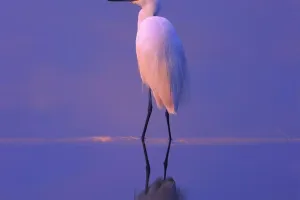When it comes to flying animals, many people may immediately think of all kinds of flying birds. However, if you want to talk about flying technology, birds may have to give way.
After all, insects flew into the blue sky as early as 300 million years ago, and there were no birds on earth at the time.
Dragonfly was one of the earliest evolutionary insects about 300 million years ago. The wings of modern dragonflies are only 2 to 5 inches, but dragonfly fossils that can reach 2 feet (almost equal to the length of the adult arm) have been discovered by science.
Dragonfly has a nearly 360 -degree vision. The head area of the dragonfly has a huge pair of eyes. This provides them with some information about the surrounding environment.
There is only one blind spot for the Dragonfly's vision, just behind them. Extraordinary vision is one of the reasons why dragonflies have almost never collided while flying and helps them detect enemies and prey from all directions.
Although the shape of the dragonfly is not particularly large, it is actually a carnivore. During the flight, the dragonfly's predation ability is particularly powerful.
It is precisely because the dragonfly's flight ability is particularly powerful and many engineers will be related to the body structure of the dragonfly when they are developing aircraft. They hope that the aircraft they develop can break a limit value in the aspect of flight.
Their hunting efficiency was so high that in a Harvard research project, they found that the dragonfly captured 90% to 95%of the prey in the fence.
Studies have shown that the wings of each dragonfly are controlled by independent muscles.
Their wings can also rotate, which means that the dragonfly can independently control the angle of the front wings and the rear wings, and the amplitude and frequency of the wing's vibration, so that the flight requirements can be achieved through different phase differences.
The functions of the two pairs of wings of the dragonfly are completely different. One pair of wings are responsible for changing the flying angle, and the other pair of wings are in a state of work independently.
Dragonfly is particularly fast during flight, and it is also agile and can change direction at will.
The dragonfly is like a helicopter, which is particularly convenient to operate. Dragonflies can stand quickly in high-speed exercise and hover in the air.
They can also change from hover to high-speed flight in a short period of time. During the flight, the dragonfly can also "turn sharply".
In addition to the flexibility of the body, the speed of the dragonfly is also fast. According to the detection made by scientific researchers, dragonflies with particularly large body shapes can even reach 100 kilometers per hour during the flight.
From this perspective, the dragonfly is called the flying king of the entire insect.
The speed of a dragonfly is not only fast but also has high endurance. In fact, the dragonfly's endurance is particularly powerful. People have observed that some dragonflies can migrate to Africa through the Indian Ocean.
In 2016, a biologist at the University of Rogers showed that a thin-winged dragonfly could cross the Pacific Ocean with a flight distance of up to 6440 kilometers.
It is the convergence of these advantages that the dragonfly has become a well-deserved hunting successor!


